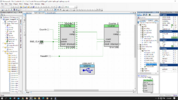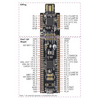Strictly for future reference, this is a single chip solution for 64 bits, could have been
at least 128 bit counter if so desired. You drag and drop components (a "component"
is an onchip resource) onto design canvas, wire up (with a wizard) to other components
and out to pins, and provide some code. I show a USBUART (also onchip) interface
which is a simple interface to PC via serial connection. Could have been parallel an/or other
serial / parallel interfaces. I estimate code at ~ 20 lines.

If you look at right hand window it shows resources used / left, so plenty of resources
left for other tasks.
IDE (PSOC Creator) and compiler free, board to use $ 15.

You can do codeless designs with this as well, eg. where you basically replicate your
approach using counters and shift registers. Again 1 chip. Its a SOC, system on chip.
Here is whats onchip, multiple copies in many cases :

Regards, Dana.









